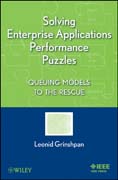
Solving enterprise applications performance puzzles: queuing models to the rescue
Grinshpan, Leonid
Poorly performing enterprise applications are the weakest links in a corporation's management chain, causing delays and disruptions of critical business functions. This groundbreaking book frames enterprise application performance engineering not as an art but as applied science built on model-based methodological foundation. The book introduces queuing models of enterprise application that visualize, demystify, explain, and solve system performance issues. Analysis of these models will help to discover and clarify unapparent connections and correlations among workloads, hardware architecture, and software parameters INDICE: Acknowledgements. Preface. Why I wrote this book? Subject. Audience. Organization. Chapter 1. Queuing networks as applications models. 1.1 Enterprise applications what do they have in common? 1.2 Key performance indicator transaction time. 1.3 What is application sizing and tuning? 1.4 Queuing models of enterprise application. 1.5 Transaction response time and transaction profile. 1.6 Network of highways as analogy of queuing model. Chapter 2. Buildingand solving application models. 2.1 Building models. 2.2 Essentials of queuing networks theory. 2.3 Solving models. 2.4 Interpretation of modeling results.Chapter 3. Workload characterization and transaction profiling. 3.1 What is application workload? 3.2 Workload characterization. 3.3 Business process analysis. 3.4 Mining transactional data from production applications. Chapter 4. Servers, CPUs, and other building blocks of application scalability. 4.1 Application scalability. 4.2 Bottleneck identification. Chapter 5. Operating system overhead. 5.1 Components of operating system. 5.2 Operating system overhead. Chapter 6. Software bottlenecks. 6.1 What is software bottleneck. 6.2 Memory bottleneck. 6.3 Thread optimization. 6.4 Other causes of software bottlenecks. Chapter 7. Performance and capacity of virtual systems. 7.1 What is virtualization? 7.2 Hardware virtualization. 7.3 Methodology of virtual machines sizing. Chapter 8. Model-based application sizing say good-bye to guessing. 8.1 Why model-based sizing? 8.2 Models input data. 8.3 Mapping system into model. 8.4 Model deliverable and what-if scenarios. Chapter 9. Modeling different application configurations. Glossary. References. Index.
- ISBN: 978-1-118-06157-2
- Editorial: John Wiley & Sons
- Encuadernacion: Rústica
- Páginas: 240
- Fecha Publicación: 17/02/2012
- Nº Volúmenes: 1
- Idioma: Inglés
